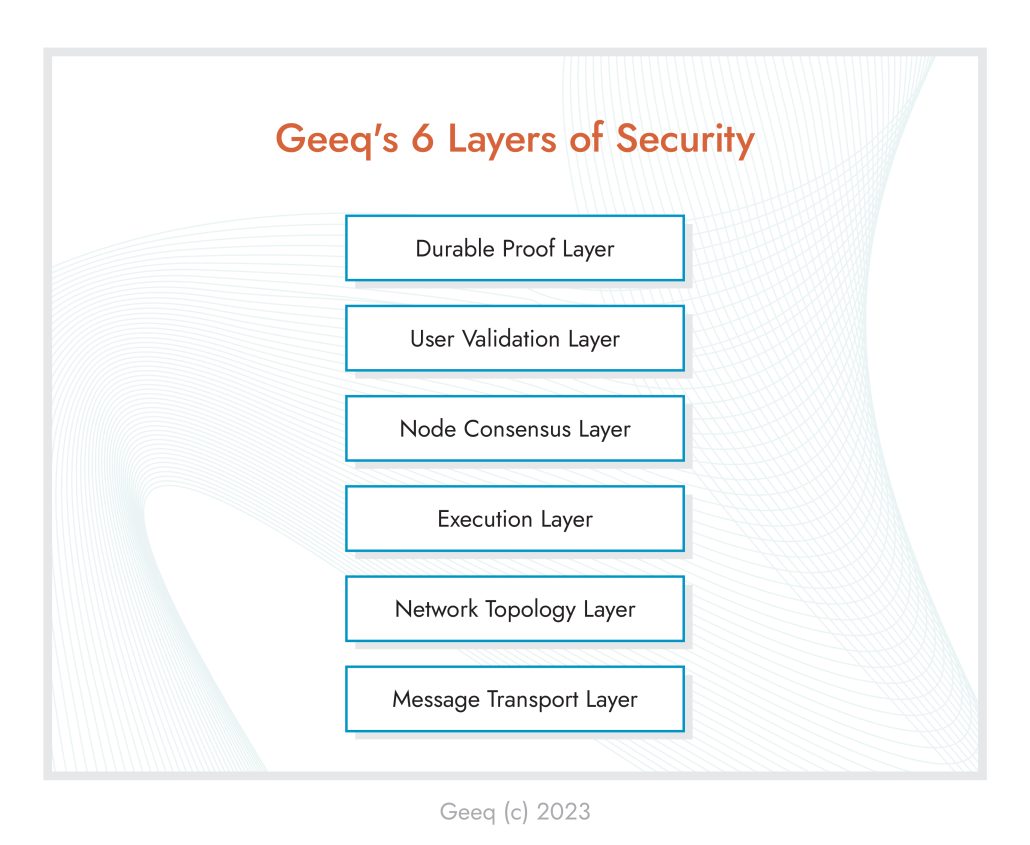By: Geeq on Nov 3, 2023
The development of Geeq’s patented technology has prioritized security from the beginning. This post briefly introduces Geeq’s 6 layers of security for technical readers who are beginning to discover Geeq.
Technical Remarks:
A brief description for each layer follows below.

From the bottom up, these are the layers that make Geeq’s blockchain protocol efficient, durable, and secure.
- Message Transport Layer – Messages are sent using a defined protocol. The current implementation uses the Capnp protocol. However, the message transport layer can be updated or replaced without affecting the layers above it.
- Network Topology Layer – Messages between network actors (i.e. Geeq nodes, hubs, and relays) can use direct communications or a gossip network to distribute messages in order to increase network throughput. Each message requires a cryptographic signature of the network actor, so network actors are individually held accountable for their actions. Network actors must attest to their own chain state view; differences in chain state views are used to trigger the automatic audit process. Please see the May 2023 Technical Update for details.
- Execution Layer – The execution layer translates actions requested by validated transactions into updates to the ledgers. In other words, each node in the active network validates the same candidate bundle of transactions first and then writes its individual blocks and ledgers. Each node builds and maintains its own blockchain. Geeq is a no-smart contracts Layer 0 protocol. By avoiding smart contracts, Geeq’s code eliminates any dependencies or attack surfaces a smart contract may introduce.
- Node Consensus Layer – The appearance of consensus at Geeq occurs when individual nodes follow Geeq’s strict, objective, fixed and measurable protocols. In this aspect, Geeq breaks radically from traditional consensus mechanisms. In traditional consensus mechanisms, it is possible for powerful nodes or social forces to influence, change, or select the rules of consensus and impose their will on others. There is always the threat a group will decide to fork away from an initial set of rules against your will, rollback blocks, or discriminate against certain transactions. At Geeq, the rules are fixed and independent of any node’s influence. The validation criteria are standardized, neutral, and each transaction is validated in the order in which it was received.
In other words, Geeq’s protocol is a non-MEV, dependably neutral, and censorship resistant protocol. - User Validation Layer: Each Geeq node must prove it has followed protocol for every block. A node’s reputation or past good behavior does not matter: if a node has been honest for 24 blocks and is malicious on the 25th block, it is audited out and the user is warned from believing the data in that node’s blockchain. Geeq provides the user this ability via an easy to use user client (an app, much like you use email via an email client). This layer is also called Edge Security.
- Durable Proof Layer – Contemporaneous proofs of validity are produced, by protocol, for each validated transaction and update to a ledger. These proofs are stateless, small, and portable. Each proof is approximately 1 kb.
If a user makes 1000 transactions on-chain and downloads a proof each time, 1 MB of storage is sufficient to prove the complete account history. No other protocol is engineered to provide that level of protection for their users. Please see the June 2023 Technical Update to learn more about Geeq’s blockchain data structures and these proofs.
Practical Remarks:
Geeq’s protocol differs from all other protocols and offers far stronger guarantees for the stability of its blockchains, the integrity of the data, and the protection of its users. The protocol itself is a non-MEV, dependably neutral, and censorship resistant protocol that offers users proofs of validity for each transaction and ledger update.
Geeq’s Layer 0 protocol is data-agnostic. It provides secure validation to any data it ingests. The data could come from enterprise or distributed business systems, payments platforms, devices, other blockchain layers, data used for AI – any data at all. The choice of data considered important enough to validate on-chain is left completely to the user: our underlying technology is the same.
One use case in the crypto blockchain space is for smart contracts, especially bridges, to improve their consumer protections. When those depend on unproven or unprovable data inputs from other chains, they can and should safeguard themselves and their users by validating the inputs to a Geeq chain before executing their contracts.
More generally, whenever your software program or you must rely on data from an untrusted source, Geeq is a means to obtain proof of the source and state of the data as it was conveyed to you. If the data turns out to be false and you relied on it, then you have protected yourself. Being able to refer to proof from an independent source is more credible and reassuring than relying on a shared central log where you or someone else may have been able to change the data.
Security and proofs are also crucial when it is important to trace exchanges of data or on-chain assets over time. The security of tracing chain of custody, data provenance and lineage, and authorizations to transact digital representations of assets is only as strong as its weakest link. At Geeq, every link is maximally secure because each transaction benefits from all six of these layers of security.
Conclusion:
A near-complete reinvention and rigorous specification of blockchain was required at each of these six layers, from the standardization of messages across transaction types to clear accountability in network communications, from the determination of rules to choose between blockchain forks to the determination of sets of validation criteria with unambiguous true-or-false answers.
With Geeq, it is now possible to synchronize data without the need for trust and conduct on-chain transactions without reliance on smart contracts. Geeq’s security work on data networks and blockchain technology is a breakthrough. It will simplify our lives now and far into the future.






To learn more about Geeq, follow us and join the conversation.
@GeeqOfficial